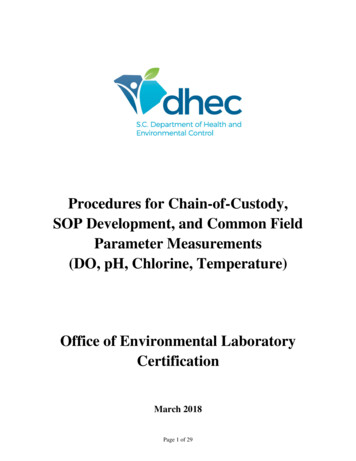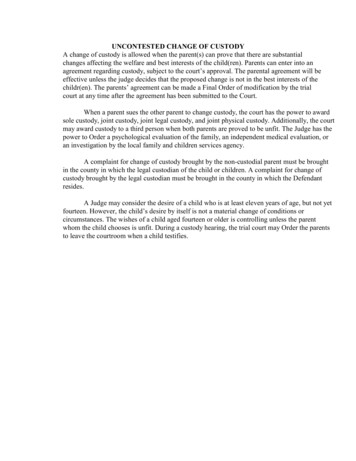
Transcription
Procedures for Chain-of-Custody,SOP Development, and Common FieldParameter Measurements(DO, pH, Chlorine, Temperature)Office of Environmental LaboratoryCertificationMarch 2018Page 1 of 29
TABLE OF CONTENTSSTANDARD OPERATING PROCEDURES (SOPS) FORMAT . 3TRAINING – DEMONSTRATION OF CAPABILITY . 5PROFICIENCY TESTING (PT) REQUIREMENTS . 5CHAIN-OF-CUSTODY . 6DISSOLVED OXYGEN (DO) . 7HYDROGEN-ION CONCENTRATION (pH) – SM 4500H B-2011 . 10RESIDUAL CHLORINE – SM 4500Cl G-2011 . 13TEMPERATURE - SM 2550B-2010 . 20RECORDS AND TRACEABILITY . 22REFERENCES . 22EXAMPLE RECORDSThermometer Accuracy Verification Record. 23Temperature Record Chart . 24Hydrogen-Ion Concentration (pH) Calibration. 25Hydrogen-Ion Concentration (pH) Sample Analysis. 26Residual Chlorine Initial Calibration Verification. 27Total / Free Residual Chlorine1 Calibration and Sample Analysis . 28Dissolved Oxygen Calibration and Sample Analysis for SM 4500 OG-2011 . 29Page 2 of 29
STANDARD OPERATING PROCEDURES (SOPS) FORMATTechnical SOPs are written instructions on how to perform a specific analytical method and/or task inthe field or laboratory. SOPs are also used to explain how to collect a sample and preserve it tomaintain the sample integrity. The SOP must explain all aspects associated with an analysis. Moreinformation concerning technical SOPs can be found 06/documents/g6-final.pdfInclude on the title page and in the header of each SOP the following information:Laboratory Name:SOP ID Number:Revision Date:Revision Number:Issue Date:Use the following format for developing a technical SOP:Parameter NameEPA Approved Method ReferenceA.Scope and ApplicabilityDescribes the purpose of the process or procedure, types of samples analyzed, and any organizationor regulatory requirements, as well as any limits to the use of the procedure.B.Summary of the MethodProvides a brief explanation of the procedure.C.DefinitionsDefines any acronyms, abbreviations, or specialized terms used in the methodology and SOP.D.Health & SafetyIncludes operations and/or chemicals that could result in personal injury or loss of life andexplains what will happen if the procedure is not followed or is followed incorrectly.E.InterferencesDescribes any component of the process that may interfere with the accuracy of the finalproduct. Includes physical or chemical properties of the sample.F.Sample Handling, Preservation, and StorageDocuments the sampling and collection requirements for each type of sample (NPDES,Drinking Water, and Solid and/or Hazardous Waste). Specifies the maximum required holdingtime from the time of collection along with the temperature and chemical preservative.Documents the storage conditions for sample analysis.G.Instrumentation and EquipmentLists all instrumentation and equipment that are necessary to perform the analysis/test.Specifies the manufacturer and model number of all instruments.Page 3 of 29
H.Reagents, Standards, and Consumable MaterialsLists all reagents, standards, and materials needed to perform the analysis/test. Specifies thesource by documenting the manufacturer, catalog number, concentration, and any otherpertinent information.I.Standard and/or Reagent PreparationDocuments the preparation procedure for all standards and reagents. Specifies theconcentration at which all standards and/or reagents are prepared and the storage conditionsand maximum holding times for all standards and reagents. Specifies the procedure fornecessary standardization of reagents and the frequency performed.J.Instrument Calibration ProceduresDocuments the calibration procedures and frequency of calibration for each instrument.Includes initial calibration and calibration verification procedures along with the acceptancecriteria for a valid calibration.K.Sample Analysis ProceduresDocuments step-by-step procedures for analyzing routine and quality control samples.L.Quality ControlIncludes all laboratory quality control practices along with the frequency and acceptancecriteria for all QC samples and calibration verifications. Describes the initial Demonstration ofCapability (DOC) and on-going demonstration of capability for all analysts. Includes theprocedures for the determination of Method Detection Limits (MDLs), if applicable.M.Data Reduction, Validation, and ReportingDescribes data reduction, calculations, and reporting procedures.N.ReferencesIncludes the references used to develop the SOP and any pertinent instrument manuals.O.Waste ManagementProvides information concerning proper waste disposal procedures for samples and/or reagentsand supplies.P.Revision HistoryDocuments the section(s) that have been modified since the last revision. Provides an ongoinghistory of the SOP modifications.The revision history should include the following information:SOPRevision #Q.RevisionDateSection ModifiedModificationAppendixInclude all appendices, tables, diagrams, etc.Page 4 of 29Reason Changed
TRAINING – DEMONSTRATION OF CAPABILITYTraining records must be maintained for all personnel. These records should include all job-relatedformal education and training taken by the analyst that pertains to any aspect to his/her responsibilities,including but not limited to analytical methodology, SOP review, laboratory safety, sampling, qualityassurance, and data analysis.An initial demonstration of capability (IDOC) must be performed for each method and each analyst. Itis a demonstration of the precision and accuracy required by the method. As stated in SM 1020B.1,each analyst must conduct an IDOC at least once before analyzing any sample to demonstrateproficiency in performing the method and obtaining acceptable results for each parameter .An ongoing or continuing demonstration of capability (CDOC) is used to document an analyst’scontinued proficiency with a method by meeting the precision and accuracy requirements. (Refer toSM 1020B.3 for guidance)PROFICIENCY TESTING (PT) REQUIREMENTSProficiency Testing Requirements can be found on our website at www.scdhec.gov/labcert. Therequired proficiency testing parameters are also specified. If you have any questions, contact theOffice of Environmental Laboratory Certification at (803)896-0970 or by email atlabcerthelp@dhec.sc.gov.Page 5 of 29
CHAIN-OF-CUSTODYEach certified laboratory must have written instructions for sample collection and handling in itsstandard operating procedures manual. To ensure sample integrity, it is required that an accuratewritten record (chain-of-custody) be available to trace the possession and handling of samples from themoment of collection through analysis and final disposition. This is referred to as chain-of-custodyand is important to ensure sample integrity and will be used in the event of litigation involving thesample results. Chain-of-custody records must include the le collection date and time.Sample collector's signature.Unique sample identification number (Assigned by the laboratory upon receipt).Sample location and description.Sample type - grab or composite.Number of containers per analysis received.Container type - glass or plastic.Analyses required.Preservatives used - H2SO4, NaOH, ice, etc.Program area - WW, DW, GW, etc.Sample matrix - liquid, soil, waste, etc.Transfer signatures w/dates and times for relinquishing and laboratory receipt. This includesrelinquishment to a laboratory refrigerator for temporary storage or other secure location.Receipts maintained when shipped by common carrier (FEDEX, UPS, etc.).Temperature upon receipt in the laboratory.Contracted analyses must be documented with the name of contract laboratory.For composite samples, the starting and ending date and time for the compositing period must be notedon the chain-of-custody record. Composite samples must be maintained at 6 C during the samplingperiod. Many facilities use refrigerated samplers. If a refrigerated sampling device is not utilized, icemust be used and replenished as needed to ensure that the sampling environment is maintained at 6 C during the 24 hour composite sampling period. The temperature of the sampling environmentmust be documented at the time the sample is harvested either in field records or on the chain-ofcustody form.Grab and composite samples must be preserved properly within 15 minutes of collection. The requiredcontainers, preservation techniques, and holding times for specific NPDES parameters are listed inTable II of 40 CFR Part 136. All chemical preservatives must be traceable to the sample container andanalysis requested. If proper preservation cannot be determined from the chain-of-custody andlaboratory verification (e.g. pH and chlorine), the analytical results will be invalid.Chain-of-custody is not required for field analyses (pH, DO, residual chlorine, and temperature) or anyother analysis performed at the collection site (such as specific conductance), since the analyses areperformed at the same time that the samples are collected. The instrumentation (brand/model) andreagents used must be traceable to the field measurements performed. Dates and times of collectionand analysis must also be traceable to field analysis results.Page 6 of 29
DISSOLVED OXYGEN (DO)Membrane Electrode Method SM 4500OG-2011Luminescence Method ASTM D888-09C and HACH 10360 Rev. 1.2Separate certification is required for the membrane electrode and luminescence DO Methods.A.Equipment and Supplies:Meter and membrane electrode probe or LDO probe.DO or LDO probe must be stored according to the manufacturer’s instructions.B.Holding Time:Samples must be analyzed within 15 minutes of collection (40 CFR Part 136 Table II). Itis strongly recommended that samples be analyzed in situ or analyzed immediately uponcollection.C.Calibration:Membrane Electrode Method: Follow the manufacturer’s calibration procedures toobtain acceptable precision and accuracy. The DO meter must be calibrated daily (eachwork shift) at the certified laboratory location prior to sample analysis in the field orlaboratory. Calibration records must reflect the calibration procedures required by themanufacturer. Documentation of all calibrations must be maintained by the laboratoryand must be readily available for review.The records must, at a minimum, include the following information provided it isapplicable to the instrument in use:Laboratory nameLaboratory ID #Meter IDDate/Time of calibrationAir temperature during calibrationAdjusted/Final DO valueTheoretical DO value - obtained from DO tables at the observed temperature andcorrected for altitude/pressureAnalyst's initialsMembrane check – indicates the laboratory has inspected the membrane and it isin operable condition (no tears, bubbles, folding, etc )Comment/Maintenance – issues, membrane replacement, etc Page 7 of 29
Additional information may be required, such as meters that require the operator to inputthe local altitude, barometric pressure, and/or the salinity of the water:Red-line checkAltitudeAltitude adjustmentBarometric pressureSalinity% SaturationLuminescent Dissolved Oxygen (LDO) Method: Follow the calibration procedures in theapproved method. The following information must be recorded:Laboratory nameLaboratory ID #Meter IDDate/Time of CalibrationTheoretical DO value - obtained from DO tables and corrected foraltitude/pressureCalibration Verification (LCS/LCSD) % recovery - The LCS/LCS duplicatesamples are water-saturated air (or air-saturated water) samples that must beanalyzed with each sample batch. Refer to the approved method for theacceptance criteria and analytical requirements.Analyst’s initialsComments/maintenance – membrane cap, probe, and battery replacementD.Sample Analysis:The sample analysis records must include, at a minimum, the following information:Laboratory nameLaboratory ID#Date/Time of sample collectionDate/Time of sample analysis (sample collection and analysis time would be thesame for samples analyzed in situ.Sample IDDissolved oxygen (DO) reading in mg/LMeter IDAnalyst's initialsCommentsPage 8 of 29
E.Quality Control:Zero check - Performed if required by the manufacturer. Document the results inthe calibration records.The DO probe’s temperature sensor must be checked for accuracy at leastannually using a NIST-traceable reference thermometer. This is required even ifthe meter is not used for reporting temperature. If the temperature differencefrom the reference thermometer is more than 1.0 C, then the probe must berepaired or replaced.If the meter has an internal barometer, the barometer must be verified foraccuracy monthly.Calibration verification - verify the instrument’s calibration by using the originalcalibration value and using the instrument supplied solubility tables to confirmthat the instrument reads within 2% or 0.2 mg/L.Initial Demonstration of Capability (IDC): Required for new analysts todemonstrate proficiency in performing a new method. The IDC is also used todemonstrate proficiency with new equipment.Page 9 of 29
HYDROGEN-ION CONCENTRATION (pH) – SM 4500H B-2011This procedure is for the analysis of pH in drinking water or wastewater using a pH metercapable of reading 0 - 14 standard units (SU), in 0.1 SU increments with a hydrogen-ionelectrode.A.Equipment and SuppliespH meter and pH electrodeB.Reagents:Standard Buffer Solutions: Commercially or laboratory prepared buffer solutions ofknown value.Commercially prepared buffer containers are labeled with received date, openeddate, expiration date, and analyst initials.Laboratory prepared buffer containers are labeled with pH value, lot #, prepareddate, expiration date, and preparer’s initials.Buffers are used within the manufacturer’s expiration date. If the manufacturerfails to provide an expiration date, the laboratory must assign an expiration date ofone year after opening in the laboratory.Buffer solutions prepared by the laboratory from pH powder pillows or liquidconcentrates can be used up to one year from the date that they are prepared.Pillow liquid concentrates must not have exceeded the manufacturer’s expirationdate.Buffers transferred to secondary containers are labeled with pH value, lot number,and expiration date.Buffers are not used more than once, a fresh aliquot is used each time the meter iscalibrated or if a buffer is checked between calibrations.Wash solution: Deionized or distilled water, preferably in a squeeze bottle.C.Holding Time:Samples must be analyzed within 15 minutes of collection (40 CFR Part 136 Table II). Itis strongly recommended that samples be analyzed in situ or analyzed immediately uponcollection.D.Calibration:Daily Calibration: The pH meter must be calibrated daily (each work shift) at thecertified laboratory location prior to sample analysis in the field or laboratory. Theinstrument must be calibrated according to the manufacturer’s instructions using aminimum of two, preferably three different pH buffer concentrations.Page 10 of 29
The pH buffers used must not differ by more than 3 Standard Units (SU). (Forexample, pH 4 and 10 buffers are more than 3 SU apart. To cover the range of pH4 to 10, the meter should be calibrated with 4, 7, and 10 pH buffers.)The pH buffers used for calibration must bracket the expected sample pH value.(For example, if the analyst expects the pH of the sample to be 8.9, then pH 7.0and 10.0 buffers should be used for the calibration.)Calibration Verification: The meter’s calibration must be verified after each calibrationwith a fresh aliquot of pH buffer. The buffer used to check the calibration will beanalyzed in the same manner as a sample and must read within 0.1 SU of the buffer’s truevalue. For example, after the meter is calibrated (standardized) with pH buffers 4, 7, and10, a pH 7.0 buffer is analyzed and the result must be between 6.9 and 7.1 SU.Otherwise the calibration is not valid.Calibration records must document, at a minimum, the following information:Laboratory nameLaboratory ID #Meter IDDate/time of calibrationpH buffers used for calibration/standardizationLot numbers of pH buffersElectrode slope or efficiency value (if displayed by the meter) – refer to electrodemanufacturer’s manualReading of the calibration verification pH buffer check (must be within 0.1 SU ofthe true value)Comments (problems, maintenance, electrode replacement, etc.)Analyst’s initialsE.Sample Analysis:Sample analysis records must be traceable to the daily calibration records. The sampleanalysis records must include, at a minimum, the following information:Laboratory nameLaboratory ID #Meter IDDate of analysisTime of sample collectionTime of sample analysis (sample collection and analysis time would be same forsamples analyzed in situ)Sample IDpH value of samplepH value of sample duplicate (see Quality Control section below)Analyst's initialsCommentsPage 11 of 29
F.Quality ControlCalibration – Refer to Section D.Calibration Verification – Refer to Section D.Initial Demonstration of Capability (IDC) – Required for new analysts todemonstrate proficiency in performing a new method. The IDC is also used todemonstrate proficiency with new equipment.Proficiency Testing (PT) Sample – Required annually.Sample Duplicates – Collect an aliquot of sample and split the aliquot into twoseparate containers for analysis. The first aliquot is the regulatory compliancesample, the results of which are recorded and used for reporting purposes. Thesecond aliquot is analyzed and results recorded for quality control purposes. Aduplicate sample is performed with each batch of samples. If however, thefacility only analyzes one sample per day, it is acceptable to perform only oneduplicate sample per week. If the pH samples are analyzed in situ, a duplicate isnot performed. Sample duplicate results must not be reported or averaged withthe original sample result. Duplicate acceptance criteria is typically 0.2 S.U.Temperature Sensor Calibration Verification – If the instrument is equipped withan automatic temperature compensator (ATC), it is recommended that the devicebe checked for accuracy against a certified NIST-traceable referencethermometer. This is required if the laboratory is reporting temperature directlyfrom the pH meter. See the “TEMPERATURE” section of this document fordetails.G.Continuous Monitoring pH – EPA 150.2Some laboratories may be using continuous monitoring instruments for the measurementof sample pH. The use of such instruments is approved for compliance monitoring aslong as they are operating in accordance with the accepted EPA analysis criteria.Therefore, such instrumentation must be calibrated at least daily to ensure the accuracy ofthe reported values. Appropriate records of the daily calibrations must be kept to verifythat the checks have been performed.Many of the continuous monitoring instruments now on the market can easily be directlycalibrated on a daily basis. Direct calibration of any instrument is always preferred.However, the Department acknowledges that direct daily calibration of some of thecontinuous monitoring devices currently marketed can be difficult, if not impossible.As an alternative to direct daily calibration, it will be acceptable for a laboratory tocompare a sample value from the continuous monitoring instrument to a sample valueobtained from a benchtop instrument that has been properly calibrated each day. For pHanalysis, the value obtained from the continuous monitor must be within 0.2 S.U. of thevalue obtained from the benchtop instrument.Page 12 of 29
RESIDUAL CHLORINE – SM 4500Cl G-2011This method is used for the analysis of free and/or total residual chlorine for drinking water orwastewater samples using the DPD spectrophotometric or colorimetric method. The SouthCarolina total residual chlorine reporting limit (practical quantitation limit-PQL) for wastewateris 0.05 mg/L.A.EquipmentSpectrophotometer or colorimeterClass A volumetric glassware and pipetsAnalytical balance (accurate to 0.0001g)B.Standards – Refer to Section H. for examples of standard preparation.Potassium Permanganate (KMnO4) Primary Stock Standard - laboratory or commerciallyprepared 1000mg/L (0.891g KMnO4/L) standard solution.Laboratory Prepared:Prepare at least every 6 monthsStore in a glass container protected from lightStore in a cool dry placeLabel with reagent name, concentration, date prepared, and analyst’s initialsCommercially Prepared:Store in a container protected from lightOnce opened, stock standard solution shelf-life is six months or manufacturer’sexpiration date, whichever comes firstLabel with date received, date opened, six month expiration date, and analyst'sinitialsStore as recommended by manufacturerPotassium Permanganate Secondary Solution - prepare a 100mg/L solution by diluting10ml of the primary stock to 100 ml with DI water.100mg/L secondary solution must be prepared at least weeklyStore in a glass container protected from lightStore in a cool dry placeLabel with reagent name, concentration, date prepared, and analyst's initialsPage 13 of 29
Potassium Permanganate Working Standard Solutions ( 100mg/L) - prepare initial anddaily calibration verification standards using the secondary solution.Prepare daily, preferably use immediatelyA minimum of two working standards used for daily calibration verificationA minimum of five working standards used for initial calibration verificationClass A volumetric glassware and pipettes (or mechanical pipettes) must be used.Chlorine Standards - commercially prepared liquid chlorine standard solutions may beused to prepare working standards in place of the potassium permanganate standards.Chlorine standards must be prepared according to the manufacturer’s instructions usingClass A volumetric glassware and pipettes and used immediately. The preparation ofchlorine standards will differ from the preparation of potassium permanganate standards.Commercially obtained secondary gel standards ( 1.0mg/L) – The concentrationestablished by the manufacturer must be used. The gel standards are not as accurate aspotassium permanganate or chlorine primary standards, therefore gel standards (at theconcentration of 1.0mg/L) may ONLY be used for calibration verification after every10 samples and at the end of the sample analysis batch. Potassium permanganate (orliquid chlorine) standards must always be used for daily (each work shift)calibration verification prior to sample analysis.C.Holding TimeSamples must be analyzed within 15 minutes of collection (40 CFR Part 136 Table II).D.CalibrationNote: When using potassium permanganate standards, the meter must be zeroed usingreagent water, not the standard.Initial Calibration Verification: Initial calibration verification is performed with a blankand at least 5 standards (potassium permanganate or chlorine liquid standards only, gelstandards cannot be used for the ICV) covering the concentration range for sampleanalyses. One of the standards must be at the reporting limit concentration. Initialcalibration verification is required for each meter on an annual basis or when a new lotnumber of DPD reagent is used, whichever comes first.Separate initial calibration verifications must be performed for free and total DPDreagents for each meter in use.A blank is required to be analyzed with the initial and daily calibration verification. Thesame source of DI water that is used to prepare the standards must be used to zero themeter prior to the analysis of the standards. For the blank, ensure the DPD reagent isadded to the DI water. The reading of the blank after this process must be documented onthe records.Page 14 of 29
All observed meter readings for the 5 standards must be within 10% of the standard’strue value (or 20% for 0.05 mg/L standard). If the standards do not meet theacceptance criteria, new secondary and/or primary standard solutions must be preparedand a new calibration verification performed.Each initial calibration verification record must be labeled with the following:Laboratory nameLaboratory ID #Identify analysis as free or total residual chlorineDate and time of calibrationAnalyst's initialsInstrument IDLot number of DPD reagentTrue concentration of standards, (mg/L)Observed concentration (meter readings) or absorbance of standards, (mg/L)Blank reading, (mg/L)Wavelength (if adjustable)Cell path length (if interchangeable)Stock Standard IDIntermediate Standard IDIf chlorine gel standards are in use, these must be verified with each initial calibrationverification and read within 10% of the manufacturer’s assigned value.Daily Calibration Verification Criteria: The instrument’s calibration must be verifieddaily (each work shift) at the certified laboratory location prior to sample analysis in thefield or laboratory, after each batch of 10 samples, and at the end of the run.The daily calibration verification must be performed before any samples are analyzedusing a minimum of two standards and a blank (potassium permanganate or chlorineliquid standards only, gel standards cannot be used for the daily calibration verificationperformed prior to sample analysis). For wastewater analyses, one of the standards mustbe at the reporting limit of 0.05mg/L.After each batch of 10 samples, and at the end of the run verify the calibration with asingle mid-level standard (potassium permanganate, chlorine liquid standards, andchlorine gel standards may be used).The daily calibration verification must be traceable to the initial calibration verificationand sample analysis records. Traceability is established by the date, time, meter ID,standard ID, and DPD reagent lot number.All observed meter readings must be within 10% of the standard’s true value (20% forthe 0.05mg/L standard). If standards do not meet the acceptance criteria, freshly preparedPage 15 of 29
secondary and/or primary standard solutions must be used to perform a new calibrationverification.Each daily calibration verification record must be labeled with the following information:Laboratory nameLaboratory ID #Identify analysis as free or total residual chlorineInstrument IDLot number of DPD ReagentDate of initial calibration verificationDate and time of daily calibration verificationBlank reading, (mg/L)True concentration of standards (mg/L)Observed concentration of the standards (mg/L)Analyst’s initialsStock Standard IDIntermediate Standard IDE.Sample Analysis:Sample analysis records must be traceable to the daily calibration verification records.The instrument’s calibration must be verified each work shift before conducting sampleanalysis.Documentation of all sample analyses must be readily available for review and must, at aminimum, include the following information:Laboratory nameLaboratory ID #Identify analysis as free or total residual chlorineInstrument IDLot number of DPD Reagent (must be traceable to initial and daily calibrationverification)Sample IdentificationDate and time of collectionDate and time of analysisSample residual chlorine value, mg/LSample duplicate result, mg/LAnalyst's initialsComment and/or sample dilution sectionPage 16 of 29
F.Sample Reporting:When reporting sample results, the laboratory cannot report values that are lower than thelowest standard concentration used to generate the initial calibration verification. Forexample, if the lowest standard used to perform the initial calibration verification is 0.05mg/L and if the meter reads less than 0.05 mg/L, then the analyst must report the value as" 0.05 mg/L". The South Carolina minimum reporting level for wastewater is 0.05 mg/L.Samples with results above the highest standard concentration used to generate the initialcalibration verification must be diluted.G.Quality Control:Daily Calibration Verification – See Section DInitial Calibration Verification – See Section DInitial Demonstration of Capability (IDC) – Required for new analysts todemonstrate proficiency in performing a new method. The IDC is also used todemonstrate that the laboratory allowed modifications to a method will produceresults as accurate and precise as the reference method.Proficiency Testing (PT) Sample – Required annually.Quality Control Sample (QCS) – Externally generated, blind QCS (unknownconcentration) at least annually, preferably semi-annually, or quarterly.Sample Duplicates – Collect an aliquot of sample and split the aliquot into twoseparate containers for analysis. The first aliquot is the regulatory compliancesample, the results of which are recorded and used for reporting purposes. Thesecond aliquot is analyzed and results recorded for quality control purposes. Aduplicate sample is performed with each batch of samples. If
Calibration verification - verify the instrument's calibration by using the original calibration value and using the instrument supplied solubility tables to confirm that the instrument reads within 2% or 0.2 mg/L. Initial Demonstration of Capability (IDC): Required for new analysts to demonstrate proficiency in performing a new method.











